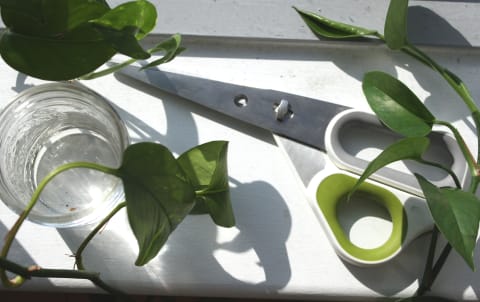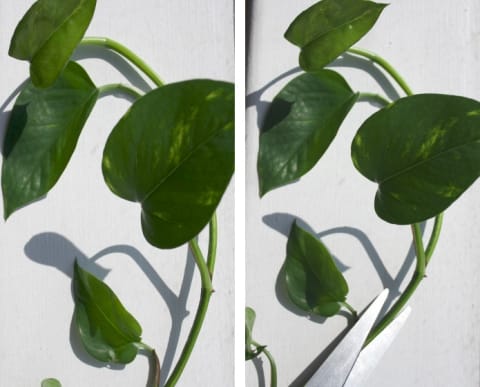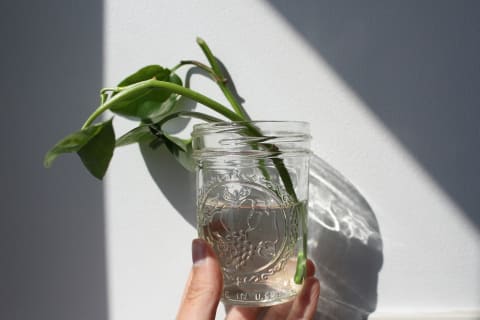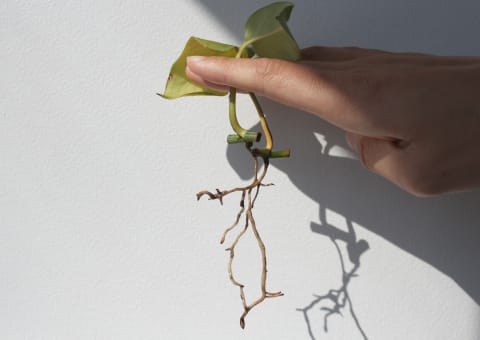Advertisement
How To Become A Propagation Expert & Make Your Pothos Plants Multiply

Propagation allows us to harness plants' natural ability to regenerate. It involves removing a part of your greenery so it can regrow into a new plant pal.
Some plants lend themselves better to the technique than others, with quick-growing pothos (Epipremnum aureum) plants being some of the easiest to propagate. Here's what you need to know to help your pothos plants multiply.
Reasons for propagating pothos:
It extends the life of a plant (and saves you money).
Darryl Cheng of House Plant Journal considers propagation a somewhat magical way to help special plants continue to thrive over time. For example, Cheng's family continues to propagate the golden pothos centerpieces from his wedding three years ago.
"Once you're comfortable with propagation, it's a long-term planning way of looking at plants," he explains, one that can also save you some serious cash at the greenhouse or plant shop.
It can help revive a sad-looking plant.
If one of your pothos plants has seen better days, propagation can help you extract any of its intact stems and, with any luck, use them to form a healthy new plant. "You can pretty much rejuvenate a whole plant by understanding propagation," Cheng says.
It puts plant trimmings to good use.
If you have an overgrown pothos on your hands, you might want to cut back a few leaves every once in a while to keep it from getting too long and leggy. Instead of tossing those clippings in the compost bin, by propagating them, you'll give them new life.
It makes for a great gift.
After "Plant Kween" Christopher Griffin gives their overgrown pothos a trim, they often gift the cuttings to friends. "My pothos is all over Brooklyn," Griffin jokes.
Depending on where your giftee is in their planting journey, you can either give them the cuttings alone, cuttings rooted in water, or a complete potted plant.
What you'll need.
To propagate your pothos using the water propagation method that experts recommend, you'll need the following:
- A healthy pothos plant
- A pair of sterile scissors or gardening shears
- Tap water
- A small clear container (Mason jars and glass vials work well here)
- Potting mix
- A pot that has a drainage hole
How to propagate pothos in water:
Step 1: Prepare your tools.

Get your scissors ready, making sure they're as clean as possible. "It's the same as surgery: If you cut it with a dirty knife, it's possible to introduce pathogens," Cheng says of why it's important to keep things fresh.
Then, grab your healthy pothos. The better condition your starter plant is in, the better likelihood of successful propagation.
"If you take a vigorous, healthy plant that has been growing in excellent light, it's in a sense bursting with life—so even if you chop it up, those little pieces have enough energy to put out new growth," he explains.
Step 2: Snip your cuttings.

Pothos plants regrow new roots from their nodes: Tiny brown bumps that grow on their stems. Cut the stem at a 45-degree angle so that your cutting contains at least one of those nodes. That's what you'll be sticking in water.
Ideally, your cutting will also contain one or two leaves—though "sometimes you can even propagate if there are no leaves at all," says Cheng. "If it's just the stem with the nodes, that by itself can grow new plants."
The more cuttings you take from your initial plant, the fuller your new propagated plant will be. Once they grow roots, you can put all those cuttings into the same pot for a fuller look. Start by taking three to four cuttings, if your starter plant allows.
Step 3: Place your cuttings in water.

Fill your clear vessel with a few inches of tap water and place your cuttings into it so their leaves are sticking up. If any leaves are submerged in the water, you can cut those off using your clean scissors. The nodes and stems are what you want to leave soaking.
Over time, the water gives the nodes an easy environment to begin forming roots. While you can technically skip the water step and just place your cuttings directly in soil, it leaves more room for error: You'll need to water the soil extra carefully, making sure it's just moist enough to give those roots a fighting chance at rooting. Putting them in water is more hands-off.
Step 4: Let it grow.

Once your cuttings are submerged in water, place them in a bright spot in your home: next to a window that doesn't get too much direct sunlight is ideal.
"[Pothos is] a plant that can tolerate lower light levels but it will always thrive in bright, indirect light," Betsy of the Betsy Begonia YouTube channel says.
Then, you're off to the races: Let your plant do its thing, replacing its water every two to three days or whenever you notice it getting murky. The water will create ideal conditions for your roots to start forming.
Over time (about one to three weeks, depending on your plant and light conditions), you should notice little white strands start to stick out of your nodes: Those are the new roots.
When the roots are about half an inch long, you can remove your cuttings and get them ready to transfer to soil.
No need to break out the measuring tape to see if you're at that half-inch mark: Since you can theoretically place cuttings directly in soil, the length of the root isn't super important. Likewise, you can leave your cuttings in water for a while, until their roots are much longer, and they should still thrive once you put them in soil.
As long as you see new roots, regardless of length, it's a sign that your cuttings should grow well.
Step 5: Put them in a pot.

Once your cuttings have rooted to your liking, remove them from the water. Put a bit of soil at the bottom of your pot. Then, with one hand holding the cuttings in the middle of the pot, pack your new soil tightly around your cuttings so they sit snugly.
Your plant's leaves might look a bit patchy at first, but over time they should fill out in the right conditions.
How to care for your new pothos.
Once your pothos cuttings are in soil, they can be treated like any other pothos plant, says Betsy. "Just put them in bright, indirect light—the brighter the better, but not full sun—and water them when the potting mix feels dry about a third of the way into the pot," she says. "I just stick my finger in the pot... If it feels dry, water."
She says that drooping leaves can be a sign your pothos needs water. A bunch of yellowing leaves usually signal you've overwatered.
"I fertilize mine every two to three months during the growing season, which is March to November in the Northern Hemisphere," she adds. "Basically when you start seeing new growth in spring you can fertilize with a balanced houseplant fertilizer."
FAQs:
Can you use the same method to propagate any type of pothos?
There are a variety of types of pothos plants, all of which respond well to this stem-cutting propagation method. (However, Betsy adds that neon and variegated varieties might grow a bit slower.)
This means that if you have a few different types of pothos plants at home, you can take a cutting or two from each and put them in the same pot to grow a fun composite plant.
This stem-cutting propagation technique also works for monstera and philodendron plants.
Can you put pothos cuttings directly into soil?
Yes, but rooting them in water first is easier. "When you grow in soil, you need to be more active with your care," says Cheng. "In water, I don't have to do anything and [the stems] will stay alive provided the right light."
How long does it take for pothos to root in water?
Typically one to three weeks, depending on the plant and light source.
When is the best time of year to propagate pothos?
Your plant will root faster in the spring and summer months, when the sun's light is more intense and conducive to growth.
Do you need to use rooting hormone?
"It isn't necessary, but if you want to go the extra mile, you can," Betsy says. Again, since pothos tend to be resilient and quick to grow, they don't really need the extra help.